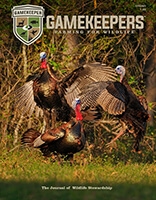We all want to see ducks hovering over our decoys in front of the blind or near the willows where we are hunkered down. For this to happen, we need sufficient openings for these birds to land where we want them to, or even to attract them to our wetland in the first place. This article outlines practices you can implement in moist-soil or agricultural wetlands to help give your wetland the right appearance to attract ducks and provide areas where they can backpedal over your decoys.

James Callicutt
At times, moist-soil vegetation can grow too tall, dense, and robust. When these rank vegetative conditions exist, ducks cannot readily access these areas due to the lack of open water present when flooded. Depending on the vegetation composition, it can take weeks to months for the vegetation to break down naturally and create openings. Research has shown that wetlands with a 50:50 mix of vegetation and open water, often called “hemi-marshes,” are highly attractive to waterfowl and other birds during both the breeding and wintering periods.
When rank vegetation occurs, these hemi-marsh conditions can be created by manipulating vegetation through mowing or disking in the fall prior to flooding. It is important to remember that standing planted crops cannot be manipulated in the year of planting, as doing so would create a baited site that cannot be legally hunted for waterfowl. However, hunting is allowed when manipulating natural moist-soil vegetation or planted vegetation that reestablishes naturally in subsequent growing seasons, such as millets or rice.
The choice between disking and mowing to create openings depends on your specific situation. Both are effective at creating open areas in dense moist-soil vegetation, but food abundance can differ between the two. Research from Mississippi State University indicates that seed and tuber abundance is greater in mowed areas than in disked. This is likely due to seeds being buried by the tillage associated with disking.
While this research found no significant difference in duck use between mowed and disked areas, it did find that ducks used manipulated areas more than areas left untouched. If the goal is to create openings and increase attractiveness by forming hemi-marsh conditions, mowing is generally preferred. Even though duck use was similar between treatments, greater seed and tuber abundance in mowed areas may support bird use further into the winter.
Using a cleated rice roller is also an effective tool for these manipulations. While the MSU study did not evaluate rolling directly, it is suspected to produce similar results and offers the flexibility of post-flooding implementation. Disking may be more appropriate if the site has not had soil disturbance in the past two years or if the plant community is dominated by undesirable species. This method allows you to create openings while also resetting plant succession for better vegetation responses the following year.
Fall is not the only time to consider these practices. Managers can also implement them in late summer to prepare areas for early teal migration. Blue-winged teal pass through our state of Mississippi from late August through early October, and a two-week hunting season takes place in September. This is typically one of the driest times of the year, and flooded habitat is often limited. Teal will use nearly any available wetland during these conditions, with deeper permanent wetlands being the most available. However, blue-winged teal prefer very shallow water depths, generally less than four inches, so shallowly flooded moist-soil wetlands are excellent habitat during this time.
Managers should prioritize marginal or less productive moist-soil units for September teal, preserving higher-quality wetlands for wintering ducks. At this point in the growing season, seed heads are mostly undeveloped, and teal primarily feed on aquatic invertebrates. Vegetation provides structure to support invertebrates, which is why teal use even marginal areas. Dense vegetation may limit teal access, especially at shallow flood depths. Mowing or disking strips or patches and then flooding to shallow depths can improve access and attractiveness for teal during this early migration window.
Similar principles apply in agricultural wetlands when managing post-harvest stubble or straw. Producers use a variety of techniques, including disking, rolling, burning, or leaving stubble in place. These practices carry agronomic trade-offs, with ease of spring planting often being a priority. As a result, many producers in the Lower Mississippi Valley disk fields after harvest to prepare for the rainy season. However, disking at this time can further reduce already limited food resources for ducks by burying waste grain. MSU research has shown that harvested fields often contain relatively little food to begin with, so further reducing this resource through aggressive tillage should be avoided. Leaving standing stubble or using treatments like burning, mowing, or rolling that avoid burying grain is better for waterfowl.

Houston Havens
MSU scientists have conducted several studies on how rice stubble management affects waste grain and waterfowl use. These studies found that standing stubble retained the most waste rice by late autumn, followed by burned, mowed, rolled, and disked treatments. On a large rice farm near Stuttgart, Arkansas, researchers observed that mallard and dabbling duck use was highest in fields that were burned or rolled and then flooded. Use was lowest in fields with standing stubble. Although standing stubble retains more waste rice, birds responded stronger to burned or rolled fields, likely due to the hemi-marsh structure these treatments create. Thus, burning or rolling stubble is recommended for maximizing both food availability and attractiveness to ducks.
Some fields are harvested using stripper-head combines, which leave very tall stubble. In these cases, manipulation is especially important, as waterfowl access issues mirror those seen in dense moist-soil vegetation when shallowly flooded. Always keep in mind that you are going for an interspersion of vegetation or stubble and open water. Many managers roll or mow the entirety of their wetland, while this might maintain the food and create open water, the hemi-marsh appearance is what entices them to sample your wetland in the first place AND limits where they can land to help improve hunting success.
Whether you are dealing with overgrown moist-soil vegetation or a harvested rice field, consider getting out there to create some well-placed openings. These simple manipulations can make your wetland much more attractive to ducks and improve your hunting success.
-
Join our weekly newsletter or subscribe to Gamekeepers Magazine.
Your source for information, equipment, know-how, deals and discounts to help you get the most from every hard-earned moment in the field.









